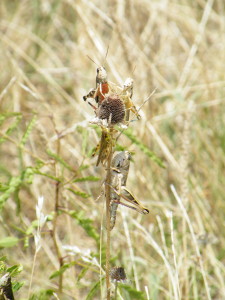The bermudagrass stem maggot (Atherigona reversura), a pest of bermudagrass forage in Texas has been reported annually since 2012. The fly (yellow with black head) lays its eggs within the stem of the bermudagrass plant. Once the egg hatches the larva, or maggot, (white with black head, 1/8” – 3/16” long) moves to the last plant node and consumes the plant material within the stem. This stem damage results in the death of the top two to three leaves while the rest of the plant remains green. This gives a stand of bermudagrass the appearance of frost damage. The amount of damage seems to be dependent on growing conditions as well as the point during regrowth when the flies lay their eggs.
Most producers will typically see the resulting damage before finding the pest. Producers are less likely to see damage in a grazing pasture since livestock will keep forage grazed down.
Management recommendations for hay meadow damage are to harvest hay as soon as possible to reduce the yield impact. If damage is found within 1 week of the normal harvest stage, proceed to harvest the crop as soon as weather conditions allow. Once the damage becomes apparent, the crop is unlikely to add a significant amount of yield. If damage is observed within 1 to 3 weeks after a harvest, it is also likely that the crop will not add a significant amount of yield. The damaged crop should be cut and baled and removed from the field as soon as weather conditions allow. Leaving the damaged crop in the field will only compete with any attempts by the plant to regrow and decrease the opportunity that the next cutting will have to accumulate dry matter.

Damage caused by the bermudagrass stem maggot (Photo courtesy of Richard Waligura, Waller County, TX)
A foliar application of any pyrethroid (beta-cyfluthrin, cyfluthrin, lambda-cyhalothrin and zeta cypermethrin) insecticide labeled for bermudagrass can control the bermudagrass stem maggot.
The fall armyworm (Spodoptera frugiperda) is a common pest of bermudagrass, sorghum, corn, winter annual grasses and many other crops in north and central Texas. Larvae of fall armyworms are green, brown or black with white to yellowish lines running from head to tail. A distinct white line between the eyes forms an inverted “Y” pattern on the face. Armyworms are very small (1/8 inch) at first, cause little plant damage and as a result infestations often go unnoticed. Larvae feed for 2-3 weeks and full grown larvae are about 1 to 1-1/2 inches long. Given their immense appetite, great numbers and marching ability, fall armyworms can damage entire fields or pastures in a few days.
Fall armyworm outbreaks in pastures and hay fields often occur following a rain which apparently creates favorable conditions for eggs and small larvae to survive in large numbers. Hay fields with dense canopy and vigorous plant growth are often more susceptible to armyworm infestations than less intensely fertilized and managed fields. Irrigated fields are also more susceptible.
Look for fall armyworm larvae feeding in the crop canopy during the late evening and early morning and during cool, cloudy weather. When fields are wet with dew, armyworms can stick to rubber boots while walking through the field.
Once larvae are greater than 3/4 inch long, the quantity of forage they eat increase dramatically. During their final 2-3 days of feeding armyworms consume 80% of the total forage consumed during their entire lifetime.
Infestations of more than 2-3 armyworms (1/2 inch or longer) per square foot may justify insecticide application. If practical, apply insecticides early in the morning or late in the evening when armyworms are most active and therefore most likely to come into contact with the pesticide.
Grasshoppers develop from egg to adult in about 40-60 days. Grasshopper egg hatch normally begins in late April to early May. Peak hatch occurs about mid-June and is usually near completion by late June. Grasshoppers can persist until late fall when adults begin to die or when a killing frost occurs. Young grasshoppers, called nymphs, feed for about 6 weeks. Once nymphs reach the adult stage, they can fly.
Monitor grasshopper infestations and treat threatening infestations while grasshoppers are still small and before they move into crops. Immature grasshoppers (without wings) are more susceptible to insecticides than adults.
The economic threshold is generally an average of 21 or more adult grasshoppers per square yard along the field margin, or 8 or more per square yard in the field. When deciding whether to treat, factor in the crop stage and value as well as the grasshopper feeding damage.
When selecting an insecticide be mindful of grazing and haying restrictions. To compare products on an economic basis, download and use the Herbicide and insecticide cost per acre spreadsheet.
Always read and follow all label instructions on pesticide use and restrictions.
Vanessa Corriher-Olson
Forage Extension Specialist
Soil & Crop Sciences
Overton, TX



